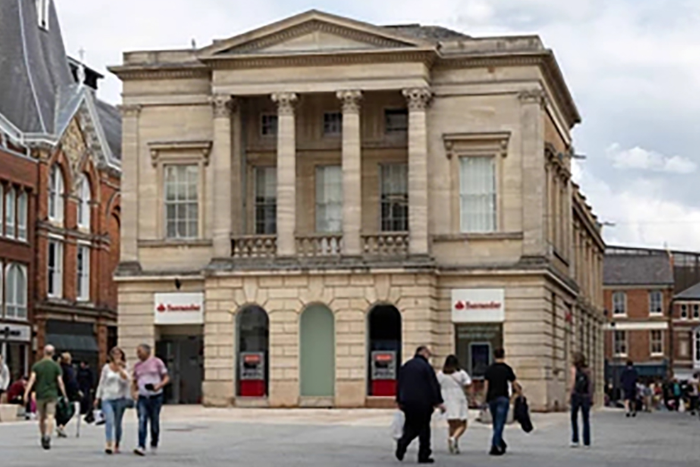
The Building of the First Lincoln Corn Exchange
By Beryl George
The Survey of Lincoln
One of the most iconic buildings in Victorian Lincoln – the first Corn Exchange on Cornhill (now Santander Bank and, until recently, Waterstones) – was opened in March 1848.
It is now a prominent building in the recently redeveloped Cornhill Quarter and back in December 1847 E. L. M. Larken wrote: “The new Corn Exchange is an improvement which has long been wanted as the merchants and corn factors had before this, no suitable place for meeting…’
There were a number of pressures encouraging the building of a corn exchange in Lincoln.
Market days in Lincoln were by all accounts, chaotic.
The Corporation ran beast markets, a butchery and butter-market, and these were all regulated to a certain extent. But there was no general market.
In 1827, J. W. Drury argued that Lincoln was in great need of one, for …the number of persons who bring commodities for the supply of the city, being obliged to erect their stalls, and range themselves along the sides of the principal street, nearly make up the road…
Although inconvenient, this arrangement was highly lucrative for the High Street shopkeepers, who charged the stall holders (illegal) fees for the privilege of trading in front of their shops. As late as 1846, it was pointed out in the press that this was influencing the discussions of a suitable site for a general market.
It was important to keep up with other towns. By the mid-1840s, concern was being expressed that if the problems of the corn market were not resolved, farmers would go elsewhere.
With the advent of the railways, the movement of goods was changing rapidly and Lincoln’s important river trade was likely to suffer. They simply had to keep up with other towns or lose trade.
As the Town Clerk remarked in October 1844: “In every place of importance corn-exchanges were now provided, or were being erected …”
Linked to this was civic pride - Lincoln was the main centre of an important agricultural county and ought to have an excellent corn exchange.
The Corn Exchange was designed by William Adams Nicholson, a well-known and respected local architect. Nicholson had prepared two different plans in 1845: one was for a single-storey building, the other two-storey, with the exchange hall on the first floor and a vegetable market under it. By 1847, the design had changed significantly.
The foundation stone was laid with great ceremony in September 1847, the new covered market opened in October 1847 and at the end of March 1848, the first corn market was held in the new Corn Exchange, as reported by the Lincolnshire Chronicle on 7 April 1848:
“The new exchange was opened last Friday for the sale and purchase of grain. The room is a very excellent one, being spacious, lofty, and well-lighted.
“The stalls have all been taken, and on Friday there was a large attendance both of buyers and sellers, who spoke in high terms of the value and accommodation of the room.”
One of the most famous early visitors to the building was Prince Albert, who came to Lincoln in April 1849 on his way to open the new docks at Grimsby. He was received in the Corn Exchange with great pomp and, once his brief visit had ended, there was a banquet for dignitaries and a ball at the corn exchange.
Civic leaders must have felt that the corn exchange was fulfilling its intended function: not only a place of business but suitable for both high ceremony and polite recreation.
Beryl George’s book, ‘Lincoln’s Cornhill Quarter: Riverside to Railway’, published by Lincolnshire Co-op, is available from the SLHA Bookshop at 2-3 Jews’ Court, Steep Hill, Lincoln, LN2 1LS.
